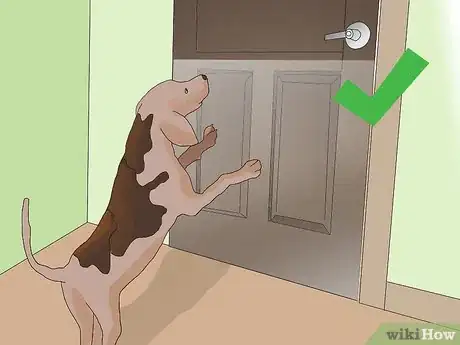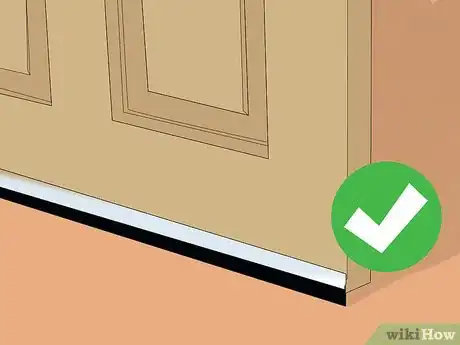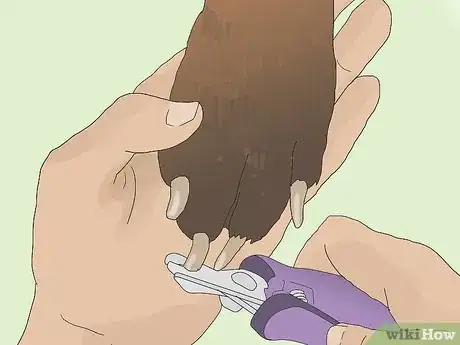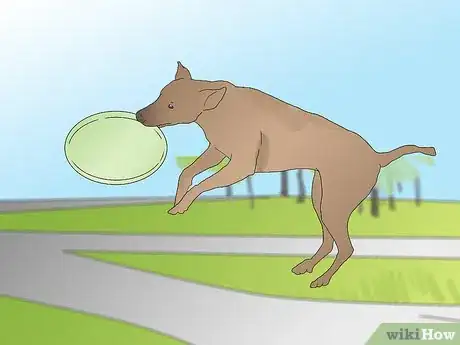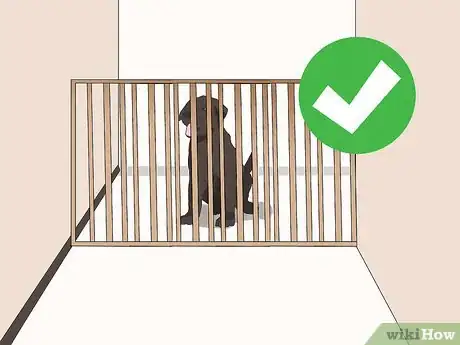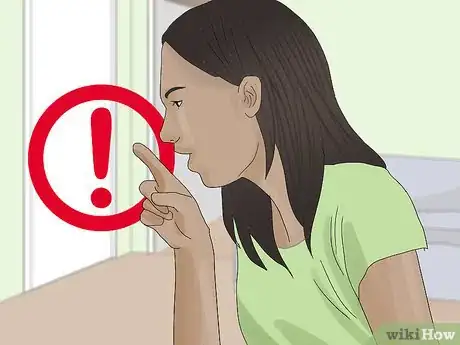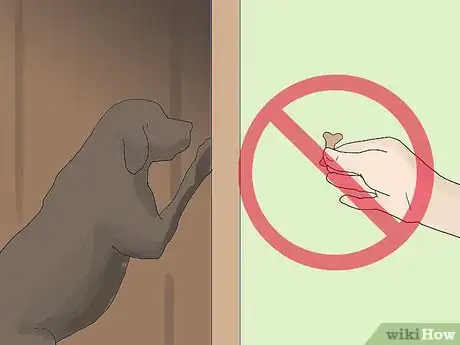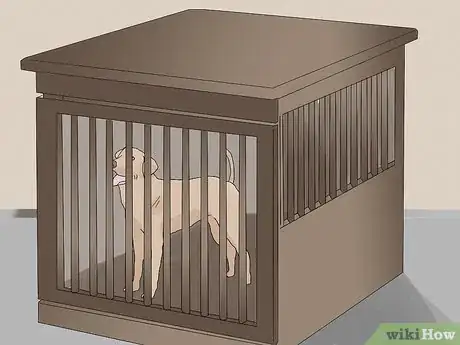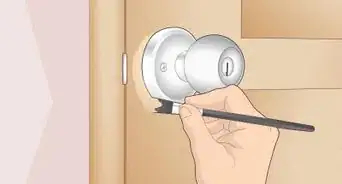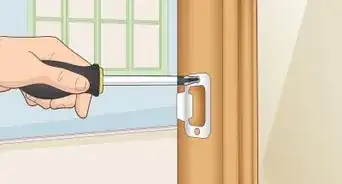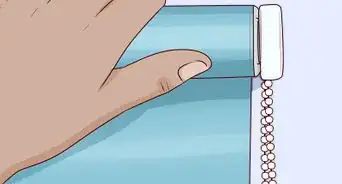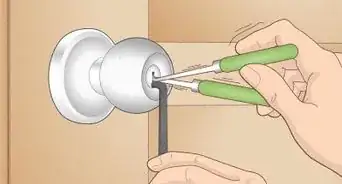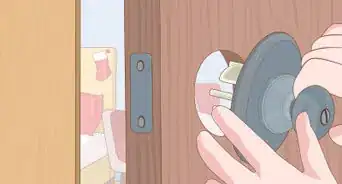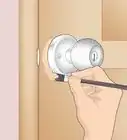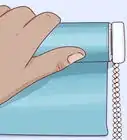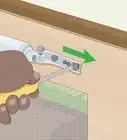This article was co-authored by Indigo Will. Indigo Will is a Canine Expert, Trainer, and Founder and Owner of K9-INDIGO® Holistic Dog Training LLC™, a dog training service in Los Angeles, California. Indigo specializes in understanding canine temperament and dispositions to allow canines to reach their full potential. He has studied various methods of training and philosophies to develop a unique, innovative, and result-driven method for canine behavior training.
This article has been viewed 69,424 times.
Dogs often scratch at doors when they’re feeling anxious, excited, or aggressive. Thankfully, you can protect your door from damage by making slight modifications to it. Even better, you can curtail your dog’s destructive behavior through some simple training and lifestyle changes.
Steps
Covering and Screening the Door
-
1Use a scratch screen to absorb the damage. Similar to a screen protector for your phone, scratch screens go on top of your door and absorb any damage caused by your dog. You can purchase plastic scratch screens at certain furniture and pet stores, or you can make a more durable screen at home by cutting out a sheet of fiberglass and fixing it to your door.
- Over time, scratch marks will begin to appear on the scratch screen itself. This indicates that it’s time to replace the screen.
-
2Install a kick plate to prevent unintended scratches. A kick plate is a thin sheet of metal that, depending on the model you get, either screws onto the surface of your door or slides onto your door’s bottom rail. When properly installed, a kick plate will prevent your dog from scratching the door while passing through it.
- Look for kick plates at home improvement stores.
Advertisement -
3Cover the door’s weather strip to protect it. In addition to the door itself, your dog may scratch up the thin weather strip between the door’s hinges and frame. To prevent this, cut a piece of vinyl lattice to the same size as your doorjamb. Then, nail your vinyl to the jamb and cover the nail holes with caulking for security.[1]
- If your dog already scratched it up, you may need to replace the weather strip with a new length of rubber or poly foam.
- You can find weather strips and vinyl lattice at most home improvement stores.
Lowering the Risk of Scratching
-
1Install a dog door so your pet can enter and exit at will. Dogs often scratch at doors when they want to go inside or outside. To fix this, you can purchase a dog door from a pet supply or home improvement store and install it near the bottom of your door.[2]
- In most cases, you can install a dog door by cutting a hole in your door with a jigsaw and pushing your dog door inside the opening. However, be sure to check your dog door’s instruction manual for model-specific information.
-
2File your dog’s nails so it can’t scratch. To file your dog’s nails, first make sure your pet is calm and relaxed. Then, grab 1 of your pet’s paws and sand the nails down using a filing tool or pumice stone. File each nail between 10 and 15 times, then repeat the process with your dog’s other paws.
- While filing, avoid the pink areas that start near the center of each nail. These contain blood vessels and nerves that, when cut, can cause your dog a lot of pain.
- If you’d like, you can clip your dog’s nails first and file them down after.
-
3Hire a dog sitter if your pet scratches while you’re away. If your dog usually scratches the door while you’re at work, school, or a similar place, consider hiring a pet sitter to come and check on it throughout the day. In some areas, you may even be able to take your pet to a doggie day care program to keep it away from your door and other valuables.[3]
- For a slightly cheaper alternative, consider hiring a dog walker instead of a sitter.
-
4Play with your dog so it’s too tired to scratch. Dogs often damage things when they have a lot of built up energy and no way to release it. To avoid this, make sure to walk your dog often and play games with it whenever it starts to act hyper.[4]
- If possible, keep playing until your dog is ready to lie down and relax.
-
5Place toys by the door to distract your dog. If you keep your dog occupied, it won’t have time to even think about the door, let alone scratch it.[5] The easiest way to accomplish this is by leaving chew toys, bones, and similar objects around the door so that, if your dog approaches the entrance, it will focus primarily on the fun objects.[6]
- In addition to toys, consider purchasing food dispensing objects that, when filled with treats, will keep your dog occupied for a long time.
-
6Block your dog's access. For a quick fix, you can simply block your dog from reaching the door. Place large objects in front of the door, such as crates or storage chests. If that doesn’t work, try installing a pet gate in front of the door.[7]
Training Your Dog Not to Scratch or Chew a Door
-
1Stop your dog if you see it scratching the door. If you catch your dog scratching or otherwise damaging the door, interrupt the action immediately. Call your dog to you, or block it from what it is doing. You might take the opportunity to place something between your dog and the door.[8]
-
2Avoid rewarding your dog for scratching. If your dog gets attention every time it scratches, it will continue scratching.Once your dog has left the door, show that it has misbehaved by ignoring it.[9]
- Punishment doesn't really work with dogs, so don't yell, hit, kick or talk down to your dog.
- If the damage happened while you were gone, don't do anything to your dog. Your dog will not understand that it is being punished.
-
3Crate train your dog to help it overcome separation anxiety. If you put your dog outside or in a separate room, it may start scratching at the door to try and get back to you. This separation anxiety is common in canines, but you can usually overcome it by placing your dog in a crate or kennel for extended periods of time.[10]
- For the best results, start by crating your dog for about 30 minutes. Once your dog can handle that amount of time, add another 30 minutes. Continue upping the time until your dog is comfortable staying in the crate overnight.
References
- ↑ https://www.todayshomeowner.com/video/how-to-prevent-pet-damage-to-weather-stripping-on-a-door/
- ↑ https://www.k9ofmine.com/dog-proof-screen-door-options/
- ↑ Indigo Will. Professional Canine Expert. Expert Interview. 8 September 2020.
- ↑ Indigo Will. Professional Canine Expert. Expert Interview. 8 September 2020.
- ↑ Indigo Will. Professional Canine Expert. Expert Interview. 8 September 2020.
- ↑ https://www.pet-happy.com/stop-your-dog-from-chewing-door-frame/
- ↑ https://www2.vet.cornell.edu/departments-centers-and-institutes/cornell-feline-health-center/health-information/feline-health-topics/feline-behavior-problems-destructive-behavior
- ↑ https://www.pet-happy.com/stop-your-dog-from-chewing-door-frame/
- ↑ https://www.pet-happy.com/stop-your-dog-from-chewing-door-frame/
Expert Q&A
Did you know you can get expert answers for this article?
Unlock expert answers by supporting wikiHow
-
QuestionWhy is my dog scratching things in the first place?
 Indigo WillIndigo Will is a Canine Expert, Trainer, and Founder and Owner of K9-INDIGO® Holistic Dog Training LLC™, a dog training service in Los Angeles, California. Indigo specializes in understanding canine temperament and dispositions to allow canines to reach their full potential. He has studied various methods of training and philosophies to develop a unique, innovative, and result-driven method for canine behavior training.
Indigo WillIndigo Will is a Canine Expert, Trainer, and Founder and Owner of K9-INDIGO® Holistic Dog Training LLC™, a dog training service in Los Angeles, California. Indigo specializes in understanding canine temperament and dispositions to allow canines to reach their full potential. He has studied various methods of training and philosophies to develop a unique, innovative, and result-driven method for canine behavior training.
Professional Canine Expert Dogs will often scratch, chew, or pee inside when they're bored. They're almost like children. What do children do when they're bored and upset? They get crayons and they draw on the wall. They don't mean to be destructive. They are just bored and they want something to do. It's the same thing with dogs.
Dogs will often scratch, chew, or pee inside when they're bored. They're almost like children. What do children do when they're bored and upset? They get crayons and they draw on the wall. They don't mean to be destructive. They are just bored and they want something to do. It's the same thing with dogs.
About This Article
To protect a door from dog scratches, place a plastic, metal, or fiberglass scratch screen in front of the door to absorb the damage. You can protect the bottom of the door by screwing a metal kick plate to it, and you can shield the door’s weather strip by fixing a piece of vinyl lattice to the door jamb. If your dog scratches at the door to get in or out, consider installing a dog door so your pet can enter and exit at will. For tips on how to prevent scratches by changing your dog’s routine and behavior, read on!
